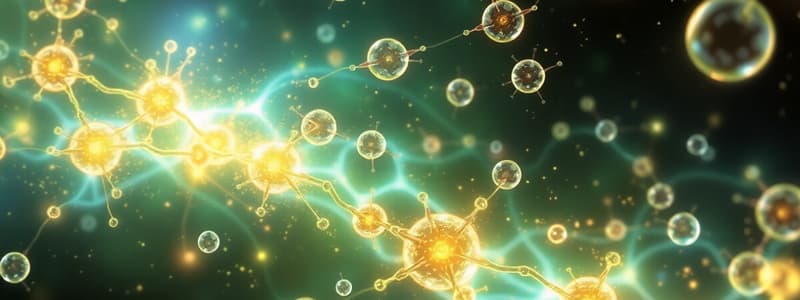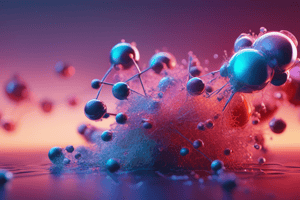Podcast
Questions and Answers
What is one of the primary roles of free radicals in relation to health?
What is one of the primary roles of free radicals in relation to health?
- They help in energy production.
- They are a significant cause of disease. (correct)
- They enhance antioxidant activity.
- They support cellular repair mechanisms.
Which of the following statements about hydrogen bonds is true?
Which of the following statements about hydrogen bonds is true?
- Hydrogen bonds only occur between identical atoms.
- Hydrogen bonds contribute to the structure of biological molecules. (correct)
- Hydrogen bonds are stronger than covalent bonds.
- Hydrogen binds covalently with oxygen and forms strong bonds.
Which characteristics are associated with hydrophilic molecules?
Which characteristics are associated with hydrophilic molecules?
- They form aggregates in aqueous solutions.
- They are water-fearing.
- They are typically nonpolar.
- They participate in hydrogen bonding. (correct)
What is the main reason hydrophobic molecules aggregate in water?
What is the main reason hydrophobic molecules aggregate in water?
What type of interactions are classified as Van der Waals interactions?
What type of interactions are classified as Van der Waals interactions?
What defines a molecule as a compound?
What defines a molecule as a compound?
Which of the following is an example of a polar molecule?
Which of the following is an example of a polar molecule?
What type of bond involves the sharing of electron pairs between atoms?
What type of bond involves the sharing of electron pairs between atoms?
What charge do cations carry after losing electrons?
What charge do cations carry after losing electrons?
What are free radicals characterized by?
What are free radicals characterized by?
Which of the following elements is commonly found in polar molecules?
Which of the following elements is commonly found in polar molecules?
What is a characteristic of nonpolar molecules?
What is a characteristic of nonpolar molecules?
Which of the following best describes the relationship between structure and function in cells?
Which of the following best describes the relationship between structure and function in cells?
What is the primary building block of proteins?
What is the primary building block of proteins?
Which of the following components can be added to proteins after synthesis?
Which of the following components can be added to proteins after synthesis?
At which pH are amino acids almost always fully charged?
At which pH are amino acids almost always fully charged?
What type of bond can be formed between charged R groups and negatively charged molecules like DNA?
What type of bond can be formed between charged R groups and negatively charged molecules like DNA?
Which category of amino acid R groups includes those that are weakly acidic or basic?
Which category of amino acid R groups includes those that are weakly acidic or basic?
What is the primary function of buffers in living systems?
What is the primary function of buffers in living systems?
Which of the following best describes the Bohr Effect?
Which of the following best describes the Bohr Effect?
How many atoms can carbon bond with at most?
How many atoms can carbon bond with at most?
Which property of water significantly contributes to its role as a solvent?
Which property of water significantly contributes to its role as a solvent?
What do amphoteric molecules do?
What do amphoteric molecules do?
Which type of organic molecule is primarily composed of carbon and hydrogen?
Which type of organic molecule is primarily composed of carbon and hydrogen?
Which of the following statements about van der Waals forces is correct?
Which of the following statements about van der Waals forces is correct?
What effect does a decrease in blood pH have on hemoglobin's oxygen affinity?
What effect does a decrease in blood pH have on hemoglobin's oxygen affinity?
Which type of fat is characterized by having no double bonds in its fatty acid chain?
Which type of fat is characterized by having no double bonds in its fatty acid chain?
What is the primary function of phospholipids in biological systems?
What is the primary function of phospholipids in biological systems?
What type of bond connects nucleotides in DNA and RNA?
What type of bond connects nucleotides in DNA and RNA?
Which of the following molecules is classified as a lipid?
Which of the following molecules is classified as a lipid?
What is the role of adenosine triphosphate (ATP) in biological systems?
What is the role of adenosine triphosphate (ATP) in biological systems?
Which of the following is a characteristic feature of steroids?
Which of the following is a characteristic feature of steroids?
Which of the following nitrogenous bases is found in RNA but not in DNA?
Which of the following nitrogenous bases is found in RNA but not in DNA?
What defines a molecule as amphipathic?
What defines a molecule as amphipathic?
What type of macromolecules perform nearly all cellular activities?
What type of macromolecules perform nearly all cellular activities?
Which kind of fatty acids have hydrogen atoms on opposite sides of the double bond?
Which kind of fatty acids have hydrogen atoms on opposite sides of the double bond?
Flashcards are hidden until you start studying
Study Notes
Superoxide and Hydroxyl Radical
- Superoxide (O2-) and hydroxyl radical (OH·) are highly reactive molecules that can readily donate or accept electrons.
- They are considered free radicals, which are unstable molecules with unpaired electrons.
Free Radicals and Disease
- Free radicals can damage macromolecules like DNA, lipids, proteins, and carbohydrates.
- They are a significant contributor to aging and various diseases.
- While free radicals are naturally produced during metabolism, aberrant or unmanaged free radicals are detrimental to health.
Hydrogen Bonds
- Hydrogen bonds form between covalently bound hydrogen atoms and the electrons of a second atom.
- They occur in biological molecules, such as the strands of DNA.
- They determine the structure and properties of water.
Hydrophilic and Hydrophobic Interactions
- Hydrophilic: Water-loving, participate in hydrogen bonding, enhance solubility in water, occur between polar molecules (e.g., amino acids, sugars).
- Hydrophobic: Water-fearing, nonpolar molecules, insoluble in water, form aggregates to minimize exposure to polar surroundings (e.g., fats, steroids).
- Van der Waals interactions: Weak bonds between hydrophobic molecules, based on electrostatic interactions.
Cellular Function and Structure
- Understanding cellular function requires knowledge of the structure of molecules and atoms.
- Structure and function in cells are closely related to the structure of molecules and atoms.
Atomic Bonds
- Atoms: The basic unit of matter consisting of a dense central nucleus surrounded by electrons.
- Covalent Bonds: Bonds between atoms formed by sharing electron pairs.
- Molecules: Stable combinations of atoms held together by covalent bonds.
- Compounds: Molecules with more than one type of atom.
Polarity
- Polar Molecules: Have asymmetric distributions of electrical charge, leading to greater reactivity.
- Nonpolar Molecules: Lack polarized bonds, generally inert (e.g., fats, waxes, CO2).
- Many biological molecules have both polar and nonpolar regions.
Ionization
- Ions: Atoms with a strong electronegativity that gain or lose electrons during chemical reactions.
- Cations: Lose electrons (e.g., Na+).
- Anions: Gain electrons (e.g., Cl-).
- Free Radicals: Unstable atoms or molecules with unpaired electrons, highly reactive and formed during normal metabolism.
Water
- Water's life-supporting qualities arise from its molecular structure:
- It is asymmetric.
- It has highly polarized O-H bonds.
- It readily forms hydrogen bonds.
- It has a high heat of vaporization.
- It is an excellent solvent for many substances.
Acids, Bases, and Buffers
- Acids release protons (H+).
- Bases accept protons (H+).
- Amphoteric molecules can act as both acids and bases (e.g., water).
- Biological processes are sensitive to pH.
- Buffers resist changes in pH (e.g., bicarbonate ions and carbonic acid buffer blood).
Carbon: The Foundation of Organic Compounds
- Carbon's size and electronic structure allow for the formation of diverse organic molecules.
- It can bind to up to four other atoms.
- It forms stable linear, branched, and cyclic carbon backbones.
Hydrocarbons
- Hydrocarbons comprise only carbon and hydrogen.
- They represent the simplest group of organic molecules, but are not common in living cells.
Common Functional Groups
- Functional groups are groups of atoms that replace hydrogens on a carbon skeleton, giving organic molecules unique characteristics and properties.
Macromolecule Classification
- Macromolecules: Large complex molecules essential for life.
- Carbohydrates
- Lipids
- Nucleic acids
- Proteins
- Building Blocks of Macromolecules: Simpler subunits that make up macromolecules.
- Sugars
- Fatty acids
- Nucleotides
- Amino acids
Lipids
- Diverse group of molecules (fats, steroids, phospholipids).
- Fats: Glycerol linked to three fatty acids by ester bonds, forming a nonpolar molecule.
- Long-term energy storage.
- Fatty Acids: Long unbranched hydrocarbon chains with a carboxyl group.
- Saturated: No double bonds.
- Unsaturated: Contains double bonds (monounsaturated or polyunsaturated).
- Cis- and trans-: Describe the hydrogen atom positions on the same or opposite sides of the double bond.
- Steroids: Built around a four-ringed hydrocarbon skeleton, nonpolar (e.g., cholesterol).
- Phospholipids: Similar to fats but with only two fatty acid chains, a phosphate group bound to glycerol, and a small polar group. Primary function in cell membranes.
Nucleic Acids
- Polymers of nucleotides that store and transmit genetic information.
- Deoxyribonucleic Acid (DNA): Stores genetic information.
- Ribonucleic Acid (RNA): Transmits genetic information into proteins.
- Nucleotide: A (deoxy)ribose sugar + a phosphate group + a nitrogenous base.
- Nitrogenous Bases: Adenine (A), Thymine (T), Guanine (G), Cytosine (C), and Uracil (U).
- Nucleotides are connected by 3'-5' phosphodiester bonds between the phosphate of one nucleotide and the 3' carbon of the next ribose sugar.
Proteins
- Macromolecules that perform virtually all cellular activities.
- Functions: Enzymes, transporters, hormones, growth factors, regulators of cell function, structural and/or movement machinery, antibodies, toxins.
- Each protein has a unique structure to enable its function and selective interactions with molecules.
- Building blocks of proteins: Amino Acids.
- Amino Acid Structure: All amino acids have a central α carbon, an amino group, a carboxyl group, and a variable R group.
- Peptide Bonds: Amino acids are joined within a polypeptide chain by peptide bonds.
- Protein Components: Many proteins contain additional components beyond the polypeptide chain, like carbohydrates (glycoproteins), metal-containing groups (metalloproteins), or organic groups (flavoproteins).
Amino Acid Diversity
- 20 different amino acids exist.
- R Groups: Variable side chains that give amino acids diverse structures and functions.
- Polar charged
- Polar uncharged
- Nonpolar
- Unique properties
Charged R Groups:
- These R groups act as strong organic acids or bases.
- They are almost always fully charged at pH 7.
- They can form ionic bonds.
- Example: Histones with arginine (+ charge) binding to negatively charged phosphate groups of DNA.
Polar Uncharged R Groups:
- These R groups are weakly acidic or basic.
- They are not fully charged at pH 7.
- They can form hydrogen bonds with other molecules.
- Example:
Studying That Suits You
Use AI to generate personalized quizzes and flashcards to suit your learning preferences.






